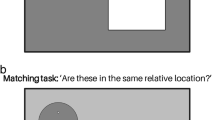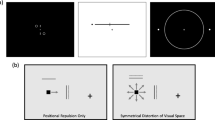Abstract
Two experiments investigated the contribution of space- and object-based coordinates to previously reported leftward perceptual biases (pseudoneglect) at various locations across visual space. Neurologically intact participants (n=34 and 27) made luminance discriminations between two left/right mirror-reversed luminance gradients (greyscales task), which were variously displaced around the midline in the participants’ left and right hemispaces. The orientations of the stimuli were manipulated so that object- and space-based coordinates were congruent or incongruent. Experiment 1 confirmed the presence of a leftward object-based perceptual bias. The bias was moderated, however, by overattention to the more central stimulus. This central spatial effect could have resulted from the use of task-specific strategies, which were controlled by presenting the stimuli sequentially in Experiment 2. The findings of Experiment 1, a leftward object-based bias and a central spatial bias, were replicated. Overall, the results indicate a leftward object-based bias and a central spatial bias, both of which are relevant for the allocation of attention. The results are discussed with reference to a variety of models of the distribution of attention across space.



Similar content being viewed by others
References
Araujo C, Kowler E, Pavel M (2001) Eye movements during visual search: the costs of choosing the optimal path. Vision Res 41:3613–3625
Arguin M, Bub DN (1993) Evidence for an independent stimulus-centred spatial reference frame from a case of visual hemineglect. Cortex 29:349–357
Ben Hamed S, Duhamel JR, Bremmer F, Graf WD (2001) Representations of the visual field in the lateral intraparietal area of macaque monkeys. Exp Brain Res 140:1445–1458
Bisiach E, Cornacchia L, Sterzi R, Vallar G (1984) Disorders of perceived auditory lateralization after lesions of the right hemisphere. Brain 107:37–52
Bowers D, Heilman KM (1980) Pseudoneglect: effects of hemispace on a tactile line bisection task. Neuropsychologia 18:491–498
Butter CM, Mark VW, Heilman KM (1988) An experimental analysis of the factors underlying neglect in line bisection. J Neurol Neurosur Ps 51:1581–1583
Carrasco M, Frieder KS (1997) Cortical magnification neutralises the eccentricity effect in visual search. Vision Res 37:63–82
Chokron S, Imbert M (1993) Influence of reading habits on line bisection. Cognitive Brain Res 1:219–222
Davidoff JB (1975) Hemispheric differences in the perception of lightness. Neuropsychologia 13:121–124
De Renzi E, Gentilini M, Faglioni P, Barbieri C (1989) Attentional shift towards the rightmost stimulus in patients with left visual neglect. Cortex 25:231–237
Downing C, Pinker S (1985) The spatial structure of selective attention. In: Posner M, Marin OSM (eds) Attention and performance XI. Erlbaum, London, pp 171–187
Driver J, Baylis GC (1989) Movement and visual attention: the spotlight metaphor breaks down. J Exp Psychol Human 15:448–456
Driver J, Halligan PW (1991) Can visual neglect operate in object-centred coordinates? Cognitive Neuropsych 8:475–496
Duncan J (1984) Selective attention and the organization of visual information. J Exp Psychol General 123:161–177
Egly R, Driver J, Rafal RD (1994) Shifting visual attention between objects and locations: evidence from normal and parietal lesion subjects. J Exp Psychol General 123:161–177
Guariglia C, Antonucci G (1992) Personal and extrapersonal space: a case of neglect dissociation. Neuropsychologia 30:1001–1009
Halligan PW, Marshall JC (1994) Toward a principled explanation of neglect. Cognitive Neuropsych 11:167–206
Halligan PW, Fink GR, Marshall JC, Vallar G (2003) Spatial cognition: evidence from visual neglect. Trends Cogn Neurosci 7(3):125–133
Heilman KM (1979) Neglect and related disorders. In: Heilman KM, Valenstein E (eds) Clinical neuropsychology. Oxford University Press, New York, pp 268–307
Heilman KM, Van Den Abell T (1979) Right hemisphere dominance for mediating cerebral activation. Neuropsychologia 17:315–321
Jewell G, McCourt ME (2000) Pseudoneglect: a review and meta-analysis of performance factors in line bisection tasks. Neuropsychologia 38:93–110
Kerkhoff G (2000) Multiple perceptual distortions and their modulation in leftsided visual neglect. Neuropsychologia 38:1073–1086
Kinsbourne M (1970) The cerebral basis of lateral asymmetries in attention. Acta Psychol 33:193–201
Kinsbourne M (1975) The mechanisms of hemispheric control of the lateral gradient of attention. In: Rabbitt P, Dornic S (eds) Attention and performance V. Academic, London, pp 81–97
Kinsbourne M (1987) Mechanisms of unilateral neglect. In: Jeannerod M (ed) Neurophysiological and neuropsychological aspects of spatial neglect. Elsevier (North-Holland), Amsterdam, pp 69–86
Kinsbourne M (1993) Orientational bias model of unilateral neglect: evidence from attentional gradients within hemispace. In: Robertson IH, Marshall JC (eds) Unilateral neglect: clinical and experimental studies. Lawrence Erlbaum Associates, Hove, UK, pp 63–86
Kwak H, Dagenbach D, Egeth H (1991) Further evidence for a time-independent shift of the focus of attention. Percept Psychophys 49(5):473–480
Làdavas E (1990) Selective spatial attention in patients with visual extinctions. Brain 113:1527–1538
Làdavas E, Petronio A, Umilta C (1990) The deployment of visual attention in the intact field of hemineglect patients. Cortex 26:307–317
Làdavas E, Paladini R, Cubelli R (1993) Implicit associative priming in a patient with left visual neglect. Neuropsychologia 31:1307–1320
Loftus GR, Masson MEJ (1994) Using confidence intervals in within-subject designs. Psychon B Rev 1:476–490
Mattingley JB, Bradshaw JL, Nettleton NC, Bradshaw JA (1994) Can task specific perceptual bias be distinguished from unilateral neglect? Neuropsychologia 32:805–817
Mattingley JB, Berberovic N, Corben L, Slavin MJ, Nicholls MER, Bradshaw, JL (2004) The greyscales task: a perceptual measure of attentional bias following unilateral hemispheric damage. Neuropsychologia 42(3):387–394
McCourt ME, Garlinghouse M (2000) Asymmetries in visuospatial attention are modulated by viewing distance and visual field elevation: pseudoneglect in peripersonal and extrapersonal space. Cortex 36:715–731
McCourt ME, Jewell G (1999) Visuospatial attention in line bisection: Stimulus modulation of pseudoneglect. Neuropsychologia 37:843–855
McCourt ME, Olafson C (1997) Cognitive and perceptual influences in line bisection: Stimulus modulation of pseudoneglect. Neuropsychologia 35:369–380
McCourt ME, Garlinghouse M, Slater J (2000) Centripetal versus centrifugal bias in visual line bisection: Focusing attention on two hypotheses. Front Biosci 5:D58–71
Mesulam MM (1983) The functional anatomy and hemispheric specialization for directed attention: the role of the parietal lobe and its connectivity. Trends Neurosci 6:384–387
Mesulam MM (1990) Large-scale neurocognitive networks and distributed processing for attention, language and memory. Ann Neurol 28:597–613
Mozer MC (2002) Frames of reference in unilateral neglect and visual perception: a computational perspective. Psychol Rev 109:156–185
Nicholls MER, Roberts G (2002) Can free-viewing perceptual asymmetries be explained by scanning, pre-motor or attentional biases? Cortex 38:113–136
Nicholls MER, Bradshaw JA, Mattingley JB (1999) Free-viewing perceptual asymmetries for the judgement of brightness, numerosity and size. Neuropsychologia 37 307–314
Nicholls MER, Bradshaw JA, Mattingley JB (2001) Unilateral hemispheric activation does not affect free-viewing perceptual asymmetries. Brain Cogn 46:219–223
Nicholls MER, Mattingley JB, Bradshaw JL, Krins P (2003) Trunk- and head-centred spatial coordinates do not affect free-viewing perceptual asymmetries. Brain Cognition 53(2):247–252
Nicholls MER, Hughes G, Mattingley JB, Bradshaw JL (2004) Are object and space-based attentional biases both important to free-viewing perceptual asymmetries? Exp Brain Res 154:513–520
Oldfield RC (1971) The assessment of handedness: The Edinburgh Inventory. Neuropsychologia 9:97–133
Posner MI (1980) Orienting of attention. Q J Exp Psychol 32:3–25
Post RB, Caulfield KJ, Welsh RB (2001) Contributions of object- and space-based mechanisms to line bisection errors. Neuropsychologia 39:856–864
Proksh J, Bavelier D (2002) Changes in the spatial distribution of visual attention after early deafness. J Cognitive Neurosci 14:687–701
Rapcsak SZ, Watson RT, Heilman KM (1987) Hemispace-visual field interactions in visual extinction. J Neurol Neurosur Ps 50:1117–1124
Riddoch MJ, Humphreys GW (1983) The effect of cueing on unilateral neglect. Neuropsychologia 21:589–599
Rizzolatti G, Camarda R (1987) Neural circuits for spatial attention and unilateral neglect. In: Jeannerod M (ed) Neurophysiological and neuropsychological aspects of spatial neglect. Elsevier (North-Holland), Amsterdam, pp 289–314
Rizzolatti G, Gentilucci M, Matelli M (1985) Selective spatial attention: one centre, one circuit or many circuits? In: Posner MI, Marin OSM (eds) Attention and performance XI. Lawrence Earlbaum, Hillsdale, NJ, pp 251–265
Schenkenberg T, Bradford DC, Ajax ET (1980) Line bisection and unilateral visual neglect in patients with neuroleptic impairment. Neurology 30:509–517
Snyder LH, Grieve KL, Brotchie P, Andersen RA (1998) Separate body- and world-referenced representations of visual space in parietal cortex (letters to Nature). Nature 394:887–891
Tant ML, Kuks JB, Kooijman AC, Cornelissen FW, Brouwer WH (2002) Grey scales uncover similar attentional effects in homonymous hemianopia and visual hemi-neglect. Neuropsychologia 40:1474–1481
Tipper SP, Behrmann M (1996) Object-centred not scene-based visual neglect. J Exp Psychol Human 22(5):1261–1278
Vallar G, Perani D (1986) The anatomy of unilateral neglect after right hemisphere stroke lesions: A CT/scan correlation in man. Neuropsychologia 24:609–622
Wolfe JM, O’Neill P, Bennett SC (1998) Why are the eccentricity effects in visual search? Visual and attentional hypotheses. Percept Psychophys 60:140–156
Zipser D, Andersen RA (1988) A back-propagation programmed network that stimulates response properties of a subset of posterior parietal neurones. Nature 331:679–684
Acknowledgements
We would like to thank Chris Davis and Jason Mattingley of the University of Melbourne and the two anonymous reviewers for their helpful comments on earlier versions of this manuscript.
Author information
Authors and Affiliations
Corresponding author
Rights and permissions
About this article
Cite this article
Orr, C.A., Nicholls, M.E.R. The nature and contribution of space- and object-based attentional biases to free-viewing perceptual asymmetries. Exp Brain Res 162, 384–393 (2005). https://doi.org/10.1007/s00221-004-2196-3
Received:
Accepted:
Published:
Issue Date:
DOI: https://doi.org/10.1007/s00221-004-2196-3




